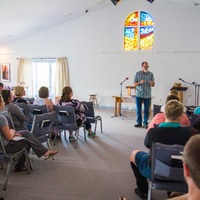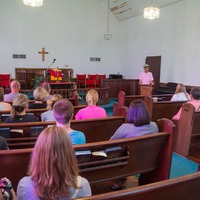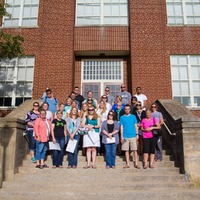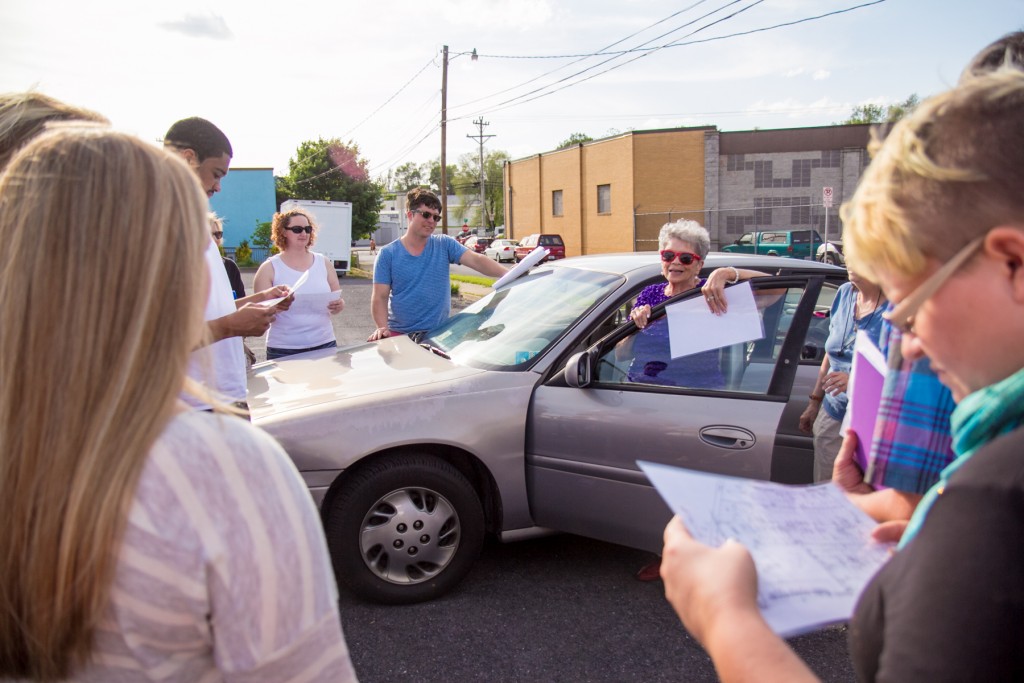Doris Harper Allen, 88, greeted a group of Eastern Mennonite University (EMU) students in the parking lot of Rose’s in Harrisonburg, the former heart of Newtown. She quickly passed out laminated maps of what is now known as the Northeast neighborhood. And then Allen flashed a vibrant smile from beneath her bright red sunglasses.
“You can ask me questions later,” she called as she climbed into her friend Robin Lyttle’s car. “Let’s go!”
Allen, who last year published a memoir “The Way It Was, Not the Way It Is” about her experiences in the Newtown area during the 1930s and ’40s, spent the evening with 28 students teaching, sharing and interpreting African American history, culture and experience.
Why a cross-cultural course in Harrisonburg, Virginia?
The “Local Context” cross-cultural course is just one way EMU students can fulfill the university’s cross-cultural requirement. While many students choose the traditional semester-long international travel, other students find that a semester living at the Washington Community Scholar’s Center (WCSC) and interning in Washington D.C. fits their needs. There are also shorter trips that work better for students with less flexible schedules, including three-week summer seminars and the local cross-cultural experience.

“If it wasn’t for the program, there’s no way I could have completed the requirement,” said Kristy Wertz as the group left the Lucy F. Simms Continuing Education Center. A nursing student, full-time patient care technician at Rockingham Memorial Hospital, wife and mother, Wertz noted the impracticality of leaving her family and job behind for a full semester, or even three weeks.
“Here I’m learning about the wide variety of populations that live in Harrisonburg, and the resources available to them. As a nurse, it’s crucial that I know how to best serve my patients. Like the parenting program we just saw,” she said, pointing back at the Simms Center. “How great was that?”
Outside Broad Street Mennonite Church, one of several historic Mennonite church plants in the northeast neighborhood, the group was greeted by Harold Huber. Huber, who began attending Broad Street in 1968 and at various times has served as administrator, secretary, trustee and historian to the congregation, passed around photos of the congregation’s early years. Allen hooted when she spotted her ten-year-old self in one of the pictures. A clutch of students gathered about her as she pointed out the bright-faced young girl.
Deanna Durham, assistant professor of applied social sciences, and her husband Byron Peachey are teaching the course this summer. The group is divided into two sections for classroom discussions and folded into one group for field trips. Durham first led a local cross-cultural in 2007; this is her fifth time teaching the course.

Like all cross-cultural trip leaders who escort students on trips, the couple are experienced inter-cultural navigators. Before coming to EMU, they spent years living and working in inner-city Washington D.C. as well as four years with Mennonite Central Committee in El Salvador. Peachey has led several cross-cultural trips to Guatemala, Cuba and Mexico, including one during the previous spring semester.
The most transformative aspect of the course, Durham says, is that students living in the Shenandoah Valley begin to think of their home differently. “I can’t tell you how many times I’ve had students say, ‘I had no idea this place, this community, this challenge…existed right here!’” she said, gesturing at the front of First Baptist Church, where the group had just listened to Judge Anthony Bailey give an impromptu talk on his role in the local justice system. “In some ways, the students in the Local Context course have a more difficult time settling back into a comfort zone once finished with their cross-cultural because it’s right in their face every day.”
Reflecting on the difference between groups that go abroad and those that stay close to home, Peachey pointed out that there are many benefits in the experience of global travel. “However,” he added, “there is great value in deeper learning about the people and places that surround you on a daily basis. Becoming familiar with various immigrant populations, learning about how Harrisonburg has grown and changed over the past half-century, these are experiences that will help these students greatly post-graduation, in their work, and how they approach interacting and engaging with the communities they are a part of.”
Peachey also noted that students on the recent Guatemala trip, which started on the U.S.-Mexico border, learned about the political clashes of immigration policy and reform and explored the personal struggles of those affected by immigration. “Those same struggles are happening right here in Harrisonburg,” said Peachey. “We just need to be willing to see them.”
A rich and surprising diversity

Additional field trips bring students on explorations into the rich diversity of the Shenandoah Valley. The African-American focus continues with trips to Zenda, a community started by former slaves in Rockingham County, and to the Franklin Street African-American Art Gallery. The gallery visit is hosted by owner Joanne Gabbin, founder and director of the Furious Flower Poetry Center at James Madison University. (Luminaries in the African-American poetry world flock to conferences and poetry summits hosted by Furious Flower, and the center offers a slate of workshops, readings, slams and lectures.)
Students also discuss immigration issues with Harrisonburg resident Isabel Castillo ’07, a nationally-known activist for DREAM Act immigration reform who founded the youth-led National Immigrant Youth Alliance.
One Friday, the students meet with Dr. Mohamed Aboutabl at the Islamic Center of the Shenandoah Valley mosque, the only place in the region for Muslims to worship. Friday prayers draw a diverse group of Muslims from around the world, with Sunni and Shia participating together.
Students also delve into the Old Order Mennonite culture, with a visit to a home for meal, accompanied by professor and Mennonite historian Nate Yoder.
At the end of the tour, the group enjoyed a meal of barbecue and deviled eggs prepared by the congregation of John Wesley Methodist Church. Allen stood in the center of the room and fielded questions from the students. They listened attentively as she described growing up in Newtown and her involvement in the civil rights movement, and how she found herself just feet away from Dr. Martin Luther King, Jr. during the 1963 March on Washington as he delivered his famous words.
“Having Doris talk to us was one of the best parts of the night,” said student Kaitlin Roadcap. “This program is teaching me to be more culturally receptive, and has really opened my eyes to the diversity in this area. I have lived here my entire life and am finally realizing just how much I didn’t know.”
